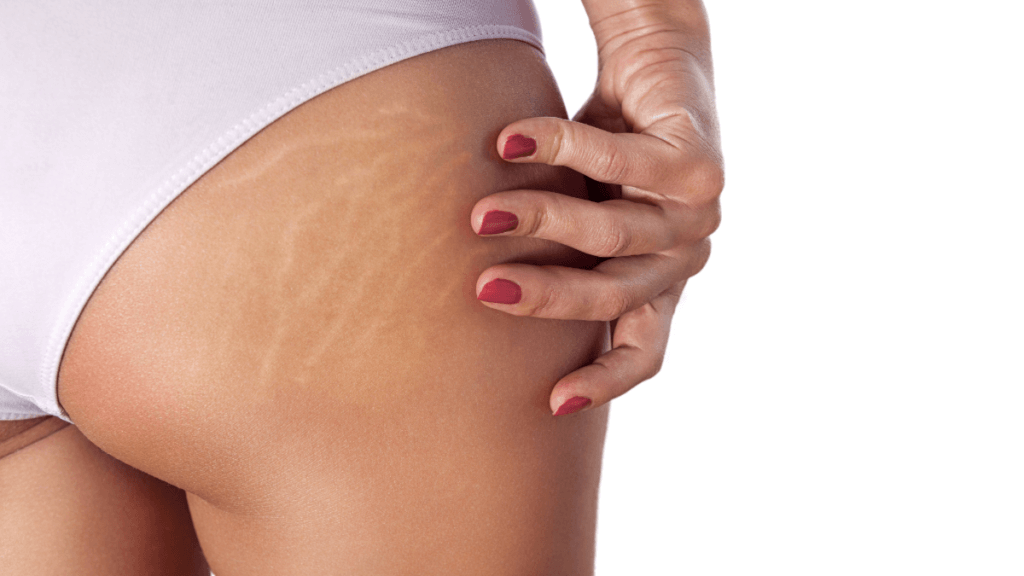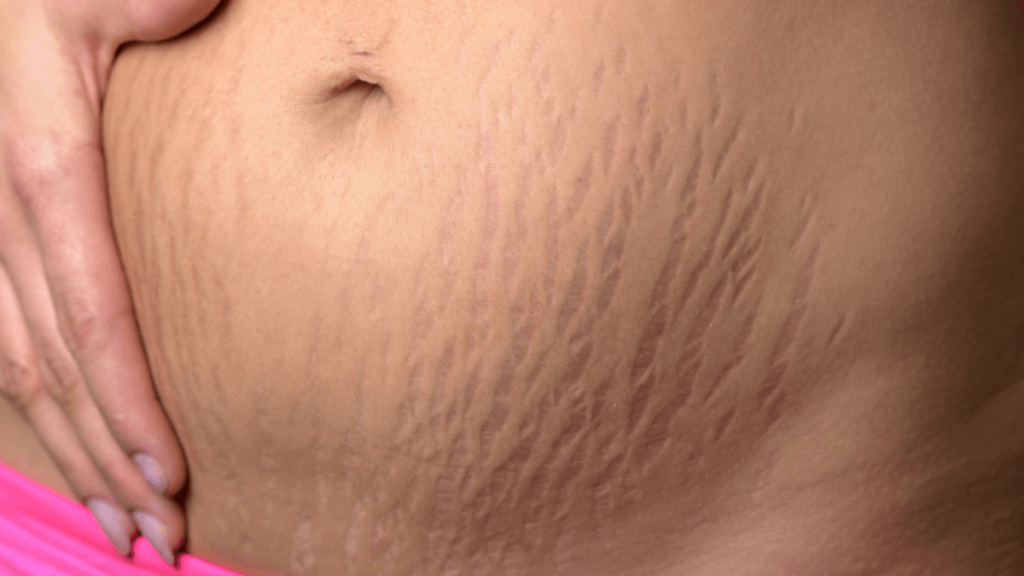Stretch marks, scientifically known as striae, are thin, linear scars that form on the skin when it’s stretched too quickly. These marks are common and can affect people of all genders, appearing on various body parts such as the abdomen, thighs, breasts, hips, and buttocks. Although they pose no medical risk, stretch marks can be a cosmetic concern for many, leading them to seek treatments to reduce their appearance.
Common Causes of Stretch Marks
Stretch marks often occur during periods of rapid growth or weight gain, including:
- Pregnancy: The body undergoes changes to accommodate the growing baby, including hormonal fluctuations and physical stretching of the skin. Hormones such as cortisol increase during pregnancy, which can weaken the skin’s elastic fibres. Combined with the expanding uterus, these changes make the skin more susceptible to developing stretch marks on the belly, breasts, and hips.
- Puberty: Stretch marks commonly develop, as teenagers experience rapid growth spurts that can cause the skin to stretch quickly. This period of accelerated growth can lead to the formation of stretch marks on areas such as the thighs, hips, and shoulders.
- Weight Gain: Rapid weight gain, whether from dietary changes or other factors, can push the skin beyond its natural elastic limits, leading to the formation of stretch marks. When the skin is forced to stretch too quickly, the underlying connective tissue can tear, resulting in these characteristic streaks.
- Bodybuilding: Intense weightlifting can cause stretch marks due to significant muscle growth that stretches the skin. As muscles enlarge rapidly, particularly in areas like the arms, shoulders, and chest, the skin may struggle to keep up, resulting in the formation of stretch marks.
Appearance and Stages

Initially, stretch marks appear as red or purple lines due to the stretching and tearing of the middle layer of the skin, known as the dermis. This early stage, called striae rubrae, is characterised by a prominent colouration that varies depending on skin tone and the underlying blood vessels that have been disrupted during the stretching process. The intensity of the red or purple hue is influenced by the level of blood flow beneath the skin, with higher blood flow making the stretch marks appear darker. During this stage, the stretch marks are more responsive to treatments, as they are still actively healing and the skin’s collagen production can be more readily stimulated.
As time passes, stretch marks transition into what is known as striae alba, where they fade to a silvery or white colour. This change occurs as the blood vessels contract and the inflammation subsides, leaving behind pale, scar-like lines that can be less responsive to treatment. The texture of these mature stretch marks can also differ from the surrounding skin, often feeling slightly raised, indented, or even wrinkled. This textural change is due to the disruption of the skin’s normal structure and the loss of collagen and elastin fibres, which are essential for skin elasticity and smoothness. As a result, older stretch marks can be more challenging to treat, and although they may fade in colour, they often remain visible as subtle, textured lines on the skin.
Key Factors Behind Stretch Marks
Stretch marks develop due to a combination of physical stretching of the skin and hormonal changes that affect its elasticity. Here are some of the primary causes:
- Hormonal Changes: Hormones such as cortisol can weaken the skin’s elastic fibres, making it more prone to tearing when stretched.
- Genetics: Genetic predisposition plays a significant role, as some individuals are more likely to develop stretch marks due to inherited skin characteristics.
- Rapid Weight Changes: Sudden fluctuations in weight, whether from gaining or losing, can overwhelm the skin’s capacity to stretch and contract, leading to the formation of stretch marks.
Treatment Options for Stretch Marks
While stretch marks are permanent, there are various treatments available that can improve their appearance and make them less noticeable. One popular approach involves using topical creams and lotions containing ingredients like cocoa butter, shea butter, and retinoids. These products can help improve skin hydration and elasticity, though their effectiveness can vary from person to person.
Another effective treatment is laser therapy, which includes options like pulsed dye laser (PDL) and fractional laser resurfacing. These lasers work by stimulating collagen production and enhancing skin texture, thereby reducing the visibility of stretch marks.
Microneedling is another technique that has gained popularity for stretch mark treatment. It involves the use of small needles to create micro-injuries in the skin, which in turn encourages the production of collagen and elastin, helping to diminish the appearance of stretch marks over time.
Additionally, chemical peels are used as a method to exfoliate the top layer of skin, promoting regeneration and potentially reducing the prominence of stretch marks. Each of these treatments offers varying degrees of improvement, and choosing the right one often depends on the specific characteristics of the stretch marks and individual skin type.
Advanced Treatments

For those seeking more advanced options, the following professional treatments are available:
- Pulsed Dye Lasers (PDL): Particularly effective for newer, red stretch marks, also known as striae rubra. These lasers work by targeting the blood vessels under the skin, which helps reduce redness and inflammation associated with early-stage stretch marks. The treatment involves directing bursts of light at the affected area, which is absorbed by the blood vessels, causing them to collapse and fade over time. Multiple sessions are usually required to achieve significant improvement, with results varying depending on the depth and severity of the stretch marks. PDL is a relatively gentle laser option, with minimal downtime and side effects such as mild redness or swelling that typically resolve within a few days.
- Fractional Lasers (e.g., Fraxel, CO2 lasers): An ideal choice for treating older, more established stretch marks, known as striae alba, which appear white or silver. These lasers work by creating microscopic wounds in the skin, prompting a natural healing response that boosts collagen production and skin regeneration. The dual action of improving both the colour and texture of stretch marks makes fractional lasers highly effective, with the potential to reduce the appearance of stretch marks by up to 80-90% over a series of treatments. Options like Fraxel and CO2 lasers can penetrate deeper into the skin, making them particularly suitable for more pronounced stretch marks. While fractional lasers are highly effective, they can involve some downtime, with possible side effects including redness, swelling, and peeling that typically subside within a week.
- Intense Pulsed Light (IPL): It uses a broad spectrum of light to target pigmented and vascular lesions in the skin, which makes it useful for stretch marks that have already lightened or turned white. Unlike lasers, IPL delivers multiple wavelengths of light, allowing it to target different chromophores in the skin. This treatment boosts collagen production and improves the overall skin tone, making stretch marks less visible. IPL is generally less invasive than traditional laser treatments and requires minimal recovery time, though multiple sessions are often needed for the best results. It’s most effective on lighter skin tones, as darker skin can sometimes absorb too much light energy, leading to discolouration.
- Microneedling with Radiofrequency (RF): Microneedling with radiofrequency is a combination treatment that enhances the benefits of traditional microneedling by adding RF energy to the mix. This approach uses tiny needles to create controlled micro-injuries in the skin, stimulating collagen and elastin production. The addition of RF energy heats the deeper layers of the skin, further boosting the collagen response and tightening the skin. This makes the treatment highly effective for improving the texture and firmness of stretch-marked skin. Multiple sessions are typically needed, and results tend to improve gradually over time as collagen continues to remodel. Downtime is usually minimal, with patients experiencing mild redness or swelling that resolves within a few days.
- Platelet-Rich Plasma (PRP) Therapy: A regenerative treatment that harnesses the body’s natural healing powers to improve the appearance of stretch marks. The process begins with a small sample of the patient’s blood, which is then processed to concentrate the platelets. These platelets are rich in growth factors that promote healing and tissue regeneration. When injected or applied to the skin, PRP can stimulate collagen production and improve skin elasticity, making stretch marks less visible. PRP therapy is often used in combination with other treatments like microneedling to enhance its effectiveness. The appeal of PRP lies in its natural approach, as it uses the patient’s own blood with minimal risk of adverse reactions.
Preventing Stretch Marks
Although it’s not always possible to prevent stretch marks, especially during significant life changes like pregnancy or puberty, there are steps you can take to reduce their likelihood. Maintaining a healthy weight is one of the most effective strategies, as avoiding rapid weight gain or loss can help minimise the risk of stretch marks.
Staying hydrated is also important, as proper hydration supports skin elasticity, making it more resilient to stretching. Additionally, the regular use of moisturising creams can be beneficial; applying products that contain ingredients like hyaluronic acid or centella asiatica can help keep the skin supple and more elastic, further reducing the chance of stretch marks developing.
Important Considerations
It’s crucial to understand that while professional treatments can significantly improve the appearance of stretch marks, they are not guaranteed to remove them entirely. Effectiveness can vary depending on the age and severity of the stretch marks, as well as individual skin types. Treatments can also be costly and may require multiple sessions, with some maintenance needed over time to sustain results.
Despite their commonality, stretch marks are a normal part of the body’s response to growth and change. They do not pose any health risks, and embracing them can be just as valid an option as seeking treatments. For those concerned about their stretch marks, consulting with a dermatologist can provide personalised advice and guidance on the best treatment options available.


